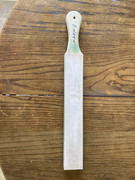- Joined
- Dec 6, 2020
- Messages
- 1,092
I wasn't really interested in doing any more work on this strop, but I thought, what the hell, let me try a 1,000 grit wet/dry sandpaper on it.

I don't think it's any cleaner, but it might be a tad smoother. Now, on to reapplying the compound. I think I'm going to use a candle to soften the compound before smearing it on. If you have any thoughts on this, let me know. Also, I am somewhere between the less-is-more and too-much-is-still-not-enough schools of thought. The surface of my Knives Plus Strop Block is all green compound, no leather showing. I wonder if that's the way to go.

I don't think it's any cleaner, but it might be a tad smoother. Now, on to reapplying the compound. I think I'm going to use a candle to soften the compound before smearing it on. If you have any thoughts on this, let me know. Also, I am somewhere between the less-is-more and too-much-is-still-not-enough schools of thought. The surface of my Knives Plus Strop Block is all green compound, no leather showing. I wonder if that's the way to go.

